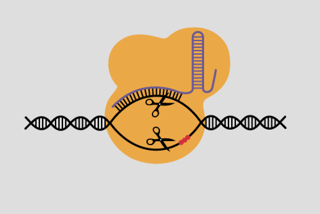
In this blog post, we will be covering one of the most important developments in the field of biology in my lifetime, CRISPR-Cas9. You may or may not cover CRISPR in an intro biology course, but you likely will cover it in upper level courses. Regardless, this topic is important enough that any new biologist should understand the very basics even if it is not “on the test”. This post will certainly not tell you everything you need to know about CRISPR, but hopefully it will give you enough information to have a sense of what it is and why it is widely considered to be such a significant addition to the field of biology.
What is CRISPR-Cas9?
CRISPR-Cas9 is a biological tool that can be used to edit the genome. CRISPR-Cas9 is made up of a few parts:
Cas9
Cas9 is an enzyme capable of cutting double stranded DNA so that new DNA can be inserted, unwanted DNA can be removed, or a gene can be knocked out (disabled).
Guide RNA (gRNA)
gRNA consists of a region of RNA that uses complementary binding to attach itself to the target region of the DNA (the place where you would like to make a cut). There is also a second region of the RNA that pulls in Cas9 and brings it to the DNA sequence at the appropriate location so that it cuts in the correct place.
Donor DNA
CRISPR-Cas9 can be used to insert new DNA into a genome. To do this you can add a third component to the CRISPR-Cas9 set up, donor DNA to be inserted at the double strand break.
Did other genome editing tools exist before CRISPR?
The short answer is yes! Scientists could induce mutations (using mutagenic chemicals or radiation) but they couldn’t entirely control where the mutation would happen or what kind of mutation would occur. The invention of CRISPR-Cas9 changed the field because it is cheap, specific, and reliable and thus far more useful than other methods.
What can you do with it and why is it potentially the most important recent discovery in biology?
This technology has widespread implications. It can be used to generate mutations or make genetic knockouts. In theory it could also be used to cure diseases caused by genetic mutations, by replacing the mutation with a normal copy of the DNA. This could have widespread implications from sickle cell anemia to cancer! Some of these problems are already being worked on in mouse models and, if they prove successful, they could transform the treatment of many diseases and raise a new set of bioethical questions.
Who invented it and where did it come from?
The technology is actually a modified form of a defense mechanism that many kinds of bacteria use. In the 1980s, scientists observed a pattern in some bacterial genomes. They saw that these genomes often contained series of repetitive DNA sequences broken up by unique DNA sequences.
Scientists named this phenomenon CRISPR and eventually discovered that it is an important part of bacterial immune systems. It turns out, that the unique sequences found in some bacterial genomes are consistent with genetic material from viruses that attack bacteria. Bacteria store viral DNA sequences in their own genetic material in order to identify these viruses when they attack. They can then use Cas enzymes to destroy the invading virus by chopping up its DNA. Once scientists understood the function of the CRISPR-Cas system, they were able to modify it and use it to edit DNA deliberately.
Many people over many years contributed to the understanding of CRISPR-Cas and the realization that it could be applied in the lab. That being said, Emmanuelle Charpentier and Jennifer Doudna are generally credited with first coming up with the idea that CRISPR could be applied to edit the genome. That being said, the patent rights for the technology remain somewhat more contested; there is an ongoing battle between the University of California and The Broad Institute over who owns the patent for different applications of this exciting technology.
Are you interested in connecting with a biology tutor like Eden to help you with your academic coursework?
Discover more from Eden below:

Comments